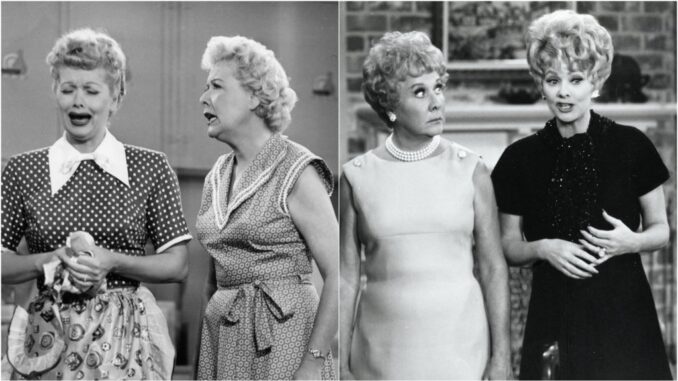
Introduction: Why ‘I Love Lucy’ Is a Cultural Landmark
Few television shows have left a legacy as enduring as I Love Lucy. This beloved sitcom not only entertained millions but also mirrored the societal norms, aspirations, and quirks of 1950s America. From gender roles to the rise of consumerism, I Love Lucy became a cultural touchstone, offering a comedic yet insightful lens into a transformative decade.
Let’s take a nostalgic journey to explore how I Love Lucy encapsulated the essence of 1950s culture and why its impact remains timeless.
The Golden Age of Television and the Birth of ‘I Love Lucy’
Television as the New Family Hearth
The 1950s were a pivotal era for television, as it became the centerpiece of American homes. Families gathered around their TV sets to watch programs that reflected their lives, and I Love Lucy emerged as the crown jewel of this golden age.
The Revolutionary Concept of the Sitcom
Before I Love Lucy, sitcoms were often live broadcasts with limited reach. Lucille Ball and Desi Arnaz broke new ground by filming in front of a live audience and using multiple cameras, a technique that set the standard for decades.
Gender Roles and Marriage in the 1950s
Lucy and Ricky Ricardo: A Typical 1950s Couple?
At first glance, Lucy and Ricky Ricardo embodied the quintessential 1950s marriage. Ricky was the breadwinner, and Lucy was the homemaker. But Lucy’s antics often challenged these roles, creating a comedic tension that resonated with audiences.
The Stay-at-Home Wife Trope
Lucy’s role as a stay-at-home wife reflected the societal expectation that women prioritize family over careers. However, her constant attempts to break into showbiz highlighted a growing desire among women to seek independence and self-expression.

Humor as a Tool for Subversion
While Lucy’s schemes often ended in disaster, they subtly questioned the rigid gender norms of the time. Her comedic defiance made audiences laugh but also think.
Consumerism and the Rise of Suburban Life
The Power of Product Placement
I Love Lucy didn’t just reflect consumer culture; it shaped it. Iconic episodes like Lucy stomping grapes or endorsing Vitameatavegamin became instant classics and boosted product sales, showcasing the growing influence of television on consumer behavior.
Suburban Dreams and Aspirations
The Ricardos’ eventual move to the suburbs mirrored the real-life migration of millions of Americans seeking the idyllic suburban lifestyle. The show tapped into the aspirations of the 1950s middle class, portraying the suburban home as a symbol of success.
Race, Ethnicity, and Breaking Barriers
A Cuban-American Leading Man
Desi Arnaz’s casting as Ricky Ricardo was groundbreaking. In an era of racial segregation, his role as a successful Cuban-American bandleader challenged stereotypes and paved the way for greater representation in media.
Interracial Marriage on Screen
The real-life marriage of Lucille Ball and Desi Arnaz brought an interracial couple into millions of living rooms. This was a bold move that subtly promoted acceptance and diversity during a time when such unions were still taboo in many parts of the country.
Comedy as a Mirror of Society
Everyday Struggles Turned Into Humor
From balancing household budgets to navigating marriage, I Love Lucy turned relatable challenges into comedic gold. This relatability was key to its widespread appeal.
Physical Comedy as Universal Language
Lucille Ball’s mastery of physical comedy transcended language and cultural barriers, making the show a global phenomenon.
The Influence of Hollywood on 1950s Culture
Lucy’s Brush With Stardom
Many episodes revolved around Lucy’s dream of becoming a star, reflecting America’s fascination with Hollywood. This theme resonated with viewers who saw stardom as the ultimate aspiration.
Guest Stars and Glamour
Cameos by Hollywood legends like Harpo Marx and John Wayne added a touch of glamour to the show, bridging the gap between television and the silver screen.
Family Values and Friendship
The Mertzes: The Ultimate Neighbors
Fred and Ethel Mertz were more than side characters; they represented the importance of community and friendship in 1950s suburban life.
Family-Friendly Entertainment
I Love Lucy was a show the whole family could enjoy, reinforcing the era’s emphasis on wholesome, family-oriented entertainment.
The Legacy of ‘I Love Lucy’ in Modern Culture
A Template for Sitcoms
From Friends to The Office, modern sitcoms owe a debt to the groundbreaking techniques pioneered by I Love Lucy.
Enduring Popularity Through Reruns
Decades later, I Love Lucy remains a staple on streaming platforms and cable networks, proving its timeless appeal.
Conclusion: Why ‘I Love Lucy’ Still Matters
I Love Lucy was more than a TV show—it was a cultural phenomenon that captured the spirit of the 1950s while subtly challenging its norms. Through humor, innovation, and relatability, it continues to entertain and inspire audiences worldwide. Whether you’re a fan of classic comedy or a student of cultural history, I Love Lucy offers a window into a transformative era in American life.
FAQs
1. Why was I Love Lucy so popular in the 1950s?
It resonated with audiences by reflecting their daily lives, blending humor with relatable themes, and pioneering new television techniques.
2. How did I Love Lucy influence future sitcoms?
The show introduced innovations like multi-camera filming and live audiences, setting the standard for sitcom production.
3. What cultural norms did I Love Lucy challenge?
The show humorously questioned gender roles, consumerism, and racial stereotypes, subtly pushing societal boundaries.
4. Why is I Love Lucy still relevant today?
Its timeless humor, relatable characters, and cultural insights continue to resonate with modern audiences.
5. What role did Desi Arnaz play in the show’s success?
As a producer and actor, Arnaz was instrumental in pioneering technical innovations and bringing diversity to television.
